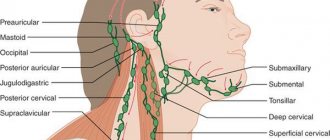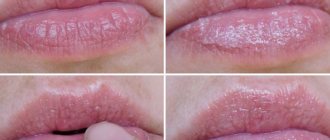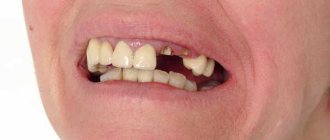Chicken pox, or chickenpox in common parlance, is an infectious disease transmitted by airborne droplets. More often, it is transmitted by children, which contributes to the formation of immunity to the infection, but adults who did not experience the disease at an early age can become infected at the age of 30–40, and their course will be much more severe.
Children tolerate the infection quite easily, despite a sharp increase in temperature, weakness and lack of appetite, and the characteristic rashes are usually found only on the skin. But there are situations of severe disease, when chickenpox in a child’s mouth is manifested by the appearance of painful vesicles. What parents should do in such a situation and how to deal with the symptoms of a complicated infection will be discussed today.
Chickenpox - definition
Chickenpox (also known as varicella) is an infectious disease of Chickenpox (Varicella).
It is caused by the varicella zoster virus. By the way, a close relative of the herpes familiar to many. All herpes are contagious, but varicella is the coolest. Chickenpox spreads through airborne droplets, and does so very actively. To catch an infection, sometimes it’s enough to look into the patient’s room for a second.
It always seemed to people that the disease was literally carried through the air, by the wind. Hence the first part of the name - wind. It was named smallpox because of the numerous rashes in the form of fluid-filled vesicles (papules), similar to those that form in smallpox.
Fortunately, chickenpox is not as deadly.
Chickenpox symptoms
Chickenpox usually lasts about ten days. The main symptom of chickenpox is a typical rash. One to two days before the rash appears, the following nonspecific symptoms may occur:
- Fever
- Decreased appetite
- Headache
- Fatigue and general malaise
The chickenpox rash goes through three stages of development:
- Pink or red spots and bumps (papules), which appear in spurts, with each new wave of fever, 2-6 shocks per day, for 3-6 days.
- After a few hours, these papules turn into blisters filled with clear liquid (vesicles), they last for a day, after which they burst and the liquid flows out
- After the blisters burst, after a few hours weeping appears - in their place crusts form, which last from several days to several weeks until new tender skin forms under them, after which they fall off.
Nutrition
An ulcerative rash with this type of disease is localized in the most unfortunate place for a child. The baby feels pain constantly, and even more so when eating. To reduce trauma to the mucous membrane, parents need to take care of a special diet for the sick child.
What to include in your diet
Food for mouth ulcers should be soft and not require chewing.
Include the following dishes on the menu:
- porridge with water, milk;
- broths;
- grated salads dressed with oil;
- compotes, herbal teas;
- yoghurts, curds without fruit additives;
- bananas;
- legumes;
- stewed cabbage with meat;
- eggs.
Children of kindergarten age at the initial stage of the disease completely refuse food for 2-3 days. During this period, take care of the amount of liquid your child drinks, add sugar and milk to tea to increase the calorie content of the drink. An appetite will appear when the acute period ends, the papules begin to heal, and the temperature drops.
What foods should you not eat?
Be sure to exclude the following set of drinks and dishes from your child’s diet:
- sweets: chocolate, cookies, ice cream, etc.;
- soda;
- natural juices from sour fruits;
- salty;
- roast;
- smoked;
- spicy;
- solid foods: nuts, seeds, crackers, etc.
The list of prohibited foods includes all foods that irritate the mucous membranes with acid and injure the tongue, gums, and throat when consumed. The oral cavity requires maximum rest during illness.
Meal schedule
A sick baby should eat 4-5 times a day in small portions. Forget about a two-course meal and compote with cookies afterwards. Prepare one dish for each meal; be sure to cool it to room temperature. Give the drink 10 minutes after eating so that the herbal infusion, tea or water washes away bacteria and food debris from the larynx, gums, and tongue, acting as a therapeutic rinse.
Chickenpox: course of the disease
Chickenpox is characterized by stages, which allows you to assess the course of the disease and navigate the quarantine period.
The incubation period of chickenpox is the time that elapses between the virus entering the body and the appearance of the first symptoms of the disease. It usually lasts 2 weeks, but can range from 10 to 21 days. The incubation period for chickenpox in adults and children is usually the same length.
The prodromal period is the initial stage of chickenpox. It is short (1-2 days), and may be absent altogether. Its characteristic symptoms are poor health, fever, muscle and headaches, and catarrhal phenomena in the nasopharynx. The first symptoms of chickenpox in adults are usually more pronounced than in children.
The rash period lasts 3-10 days. Elements of the rash appear in waves, this is accompanied by an increase in body temperature and poor health. 1-2 days pass between “waves” of rashes. There are usually 2-5 of these “waves”, then new elements stop appearing and gradually heal. The next stage begins - healing.
The recovery period begins from the moment when new elements cease to form, and all that appear become covered with crusts.
The period of convalescence (recovery) after chickenpox can last up to 1 year. The varicella-zoster virus causes a serious blow to the human immune system, and the process of its recovery is usually quite long. During this period, the body's resistance to other viral infections, such as ARVI, decreases.
How many days chickenpox lasts depends on the individual characteristics of the disease, the patient’s age, and the state of his immunity. On average, from the moment the first signs of chickenpox appear in a child until the elements of the rash completely heal, 3 weeks pass; in adults it may be longer.
Prevention
{banner_banstat9}
It is almost impossible for a child to avoid infection with chickenpox, since he is constantly in contact with other people. The main method of prevention is strengthening the body’s protective functions and observing hygiene rules.
Important! Vaccination against chickenpox is not included in the list of mandatory vaccines for children; parents can vaccinate with Okavax and Varilrix for a fee - the average cost of the procedure is 2.5–4.5 thousand rubles.
Types of chickenpox (classification of chickenpox).
Chicken pox occurs in typical and atypical forms and in terms of severity is mild, moderate and severe. Chickenpox is also classified according to ICD-10 (with meningitis, encephalitis, pneumonia).
Atypical forms of chickenpox are divided into:
- Hemorrhagic form - a common consequence of this form is bleeding, and this form occurs in people with thrombocytopenia.
- Pustular form - develops when a bacterial agent is attached.
- Gangrenous form - can lead to the development of sepsis and occurs most often in patients with weakened immunity.
- The generalized (visceral) form of chickenpox is characterized by development in patients with immunodeficiency. It is very difficult, the symptoms are more pronounced and often ends in death for the sick person.
- The rudimentary form is found in children who received immunoglobulin during the incubation period. It flows quite easily.
The severity of chickenpox is directly determined by the degree of intoxication syndrome and its criteria, as well as the presence of specific vesicular rashes on the skin and mucous membranes. It should be noted that there are also so-called abortive (very mild) cases of the disease, which occur without the appearance of fever and are characterized by the appearance of single rashes on the skin of the abdomen and back. Such chickenpox is detected in kindergarten during examinations during outbreaks.
To the question “how long does chickenpox last?” It is difficult to answer unequivocally, since the duration of the disease directly depends on the form and course of chickenpox. On average, in the classical (typical) course, the duration of the disease is from 12 to 16 days.
Causes
Often a child gets sick for the first time during teething. It prevents you from brushing the area where the tooth is erupting. As a result, infection accumulates in this place and inflammation of the gum tissue occurs, which gradually spreads. It is aggravated by frequent allergic reactions to introduced complementary foods.
In older children, pathology is provoked by the following reasons:
- mechanical microtraumas - damage to gum tissue occurs when brushing teeth with hard brushes or hard food when biting it;
- the introduction of herpes is provoked by other viral or infectious lesions of the oral cavity;
- the presence of polyps in the nasal cavity and breathing problems contribute to the penetration of an infectious agent into the gum tissue;
- an incorrect bite in a child leads to constant trauma to the mucous membrane and the development of inflammation;
- lack of nutrients, vitamins and microelements in the baby’s diet reduces local immunity;
- the manifestation of a viral infection is provoked by burns in the mouth;
- Dental diseases (caries, pulpitis) contribute to the development of the virus in the gum tissue, weakening local immunity.
The infection spreads to other tissues quite quickly, and isolated gum damage spreads to periodontal structures.
Diagnosis of chickenpox
The basis for detecting herpes is a virological study - examination of media to detect the pathogen. In case of chickenpox, for diagnosis, liquid from vesicles is used, in which, when stained, accumulations of the pathogen, the Argan corpuscle, are isolated.
Chickenpox is usually distinguished from insect bites. The main difference is the lack of development of elements and bedding, as well as normal body temperature.
Also, the disease should be differentiated from:
- streptoderma - occurs without fever, the rash is different - cloudy, purulent contents, after involution leaving a yellow crust, in its place a red spot forms. The rash is located mainly behind the ears and on the extremities, never on the scalp (a hallmark of chickenpox).
- herpes zoster - the blisters are located strictly along the nerve trunk; they practically never occur on the legs and arms.
- vesicular rickettsiosis - a small scab forms at the site of the tick bite, followed by the formation of an ulcer (a scar forms in its place after healing). Enlargement of regional lymph nodes is typical.
When to see a doctor?
If you suspect that you or your child has chickenpox, consult your doctor. The doctor will be able to make a diagnosis simply by examining you, studying the elements of the rash and accompanying symptoms. Your doctor may also prescribe medications to reduce the severity of chickenpox and reduce the risk of complications, if necessary. Call the pediatrician in advance and warn that you suspect chickenpox - the doctor will see you in a separate room, without waiting in line, to avoid the risk of infecting other patients.
Also, be sure to tell your doctor if you have any of these complications:
- The rash has spread to one or both eyes.
- The skin around some parts of the rash becomes very red, hot, or painful, indicating a secondary bacterial skin infection.
- The rash is accompanied by dizziness, disorientation, rapid heartbeat, shortness of breath, tremors (shaking hands), loss of muscle coordination, increasing cough, vomiting, difficulty bending the head forward, or a fever above 39.4 C.
- a history of any immunodeficiency, or age younger than 6 months.
How to treat chickenpox
Chickenpox is a virus. And, like most viruses, there is no specific treatment for it. Helping a sick person comes down to alleviating the main symptoms.
Fever and headache
Remember: paracetamol and nothing else! Popular painkillers and antipyretics based on ibuprofen should not be taken. The use of nonsteroidal anti-inflammatory drugs and the risk of serious skin and soft tissue complications in patients with chickenpox or herpes zoster have been reported to indicate that ibuprofen for chickenpox increases the incidence of complications such as skin infections.
Aspirin is completely contraindicated. In conjunction with the varicella-zoster virus, it has a powerful toxic effect on the liver and brain (the so-called Reye's syndrome).
Itching
To relieve itching, your doctor may recommend an antihistamine. Considering the insidiousness of the virus, under no circumstances prescribe it to yourself!
You can also treat your skin with calamine lotion according to the instructions.
Scratches and wounds
To avoid scratching the skin and causing infection in the wounds:
- Trim your nails as short as possible. If your baby is sick, put on thin protective gloves.
- Wear clean, loose clothing.
- Change your underwear and bed linen more often.
It is not necessary to smear the rashes with brilliant green: brilliant green will not speed up the maturation of the blisters. The color only helps to mark pimples in order to track the moment when new ones stop appearing.
Soreness in the mouth
If there are rashes on the oral mucosa, doctors recommend eating sugar-free popsicles. The cold will help relieve discomfort. Also try not to eat salty and spicy foods.
Treatment tactics
How to treat chickenpox in a child’s mouth in order not only to relieve him of pain, but also to ensure faster healing of the ulcers? There are several points for this, following which you can achieve positive results.
Nutrition
First of all, the child needs to be provided with adequate nutrition, despite the lack of appetite. Food should not be irritating, so as not to hurt already painful and bleeding wounds; preference should be given to liquid dishes and drinks:
- puree;
- porridge;
- pureed soups;
- vegetable and meat (low-fat) broths;
- yoghurts, kefir.
Sour and salty foods should be completely excluded from the child’s diet during illness, and after each meal it is recommended to rinse the mouth with boiled water or an antiseptic solution. Maintaining a proper drinking regime is considered important.
Plentiful amounts of fluid will help remove toxins from the baby’s body, replenish water balance and improve immunity. Tinctures and decoctions of medicinal plants - rose hips, chamomile, sage - are well suited for this purpose. You can cook compote from fresh (non-acidic) berries; it will saturate the body with vitamin C, which is necessary to speed up recovery.
In addition to juices and fruit drinks, the child needs to drink clean water, milk or green tea
Mouth rinse
Treatment of chickenpox in children must necessarily include such an item as rinsing the mouth. This measure will ensure disinfection of the mucous membranes and prevent the penetration of secondary infection into the damaged epithelial layers.
Your baby can rinse his mouth with the following means:
- chamomile tincture - to prepare it you need to pour 1 tbsp. l. dry flowers with a glass of boiling water, let the composition stand and cool for 15–20 minutes, and then use it for rinsing;
- Furacilin solution - it is prepared at the rate of one tablet per 100 ml of water. You can boil the required amount of the drug in water for several minutes or put the tablets in liquid and wait for complete dissolution. Rinsing with a cooled mixture should be carried out at least 4 times a day;
- soda solution - you need to dissolve 1 teaspoon of the product in 250 ml of boiled, warm water, rinse the mouth 3-4 times a day;
- Miramistin - rinsing with this pharmaceutical antiseptic should be carried out at least 4 times a day, one procedure will require 10–15 ml;
- potassium permanganate solution (potassium permanganate) - to prepare it correctly, the main thing is not to overdo it with the amount of dry powder. For a child, a few crystals of potassium permanganate dissolved in warm boiled water will be enough to turn it light pink;
- green tea - a freshly brewed drink is cooled to a temperature of 28–30 oC and given to the child for rinsing at least 3–4 times a day.
If the child is too small and cannot rinse the mouth properly, the surface of the mucous tissue can be treated with the listed compounds by wrapping a piece of sterile bandage around a clean finger.
External treatment products
How to treat the mucous membrane of a child’s mouth in order to speed up the healing of painful wounds that cause him severe discomfort? To do this, you can use the following tools:
- sea buckthorn oil – promotes softening, disinfection and accelerated healing of mucosal tissues;
- Chlorophyllipt is a medicine made from eucalyptus leaves, known for its anti-inflammatory, antiseptic and healing properties. To achieve an antimicrobial effect, you need to carefully smear chickenpox in your mouth with an oil solution several times a day;
- Kalgel - this drug is intended to anesthetize bleeding ulcers and prevent secondary infection; it perfectly stops the proliferation of pathogenic microbes and disinfects the mucous membrane;
- Solcoseryl paste - the product will ensure the restoration and regeneration of damaged tissues for 5 consecutive hours after application;
- Fukortsin is an antiseptic drug that is applied to the surface of the mucous membranes 2-3 times a day using a cotton swab. It promotes the healing of erosions in the mouth, prevents secondary infection and accelerates the healing of affected areas.
Drugs for the treatment of oral pathologies in children accompanied by pain and inflammation
It is necessary to treat a child for chickenpox, complicated by rashes on the oral mucosa, under the supervision of a doctor, informing him of all changes in the baby’s health. You need to treat the oral cavity carefully, without pressure, so as not to provoke repeated bleeding of the ulcers, using sterile materials - cotton wool, bandage or gauze.
What complications can occur with chickenpox?
The disease is usually mild, but complications may occur, including bacterial infections (eg, bacterial skin lesions, pneumonia) and neurological infections (eg, encephalitis, meningitis, myelitis), which can be fatal.
Secondary bacterial skin infections, which are caused by streptococcus or staphylococcus, are the most common cause of hospitalization and outpatient medical visits. Secondary infection with invasive group A streptococci can cause abscesses and cellulitis.
Pneumonia after chickenpox is usually viral, but can also be bacterial. Secondary bacterial pneumonia is more common in children under 1 year of age. It is characterized by an increase in temperature up to 40⁰C, an increase in pallor and cyanosis of the skin, the appearance of a substernal dry cough and shortness of breath. Patients can take a forced position in bed.
Damage to the central nervous system in chickenpox ranges from aseptic meningitis to encephalitis. Cerebellar involvement followed by cerebellar ataxia is the most common presentation of central nervous system disorders but usually has a positive outcome.
Encephalitis is one of the most dangerous complications of chickenpox (10-20% of cases are fatal). This complication manifests itself as headache, nausea, vomiting, convulsions and often leads to coma. Diffuse brain involvement is more common in adults than in children. Chickenpox meningitis may occur together with encephalitis or independently.
Rare complications of chickenpox include Guillain-Barré syndrome, thrombocytopenia, hemorrhagic and bullous chickenpox, glomerulonephritis, myocarditis, arthritis, orchitis, uveitis, iritis and hepatitis.
Once infected, the virus remains hidden in nerve cells and can be reactivated, causing a secondary infection, herpes zoster. It usually occurs in adults over the age of 50 or with a weakened immune system and is associated with a painful rash that can cause permanent nerve damage.
Possible consequences and complications
The negative consequences of chickenpox in children are rarely diagnosed; most often, dermatological purulent complications occur - abscess, phlegmon, boils, which leave scars. If the disease is severe, the virus affects internal organs and dangerous concomitant diseases develop.
Possible consequences of chickenpox:
- Encephalitis - pathology manifests itself 7–12 days after the onset of the disease, characterized by frequent convulsions, severe headache, and impaired consciousness. In rare cases, idiocy develops.
- Myocarditis - the virus provokes the development of an inflammatory process in the heart muscle, shortness of breath occurs, the pulse rate is disturbed, and the child may complain of chest pain.
- Pneumonia – occurs in infants with neonatal chickenpox; the condition is dangerous and can be fatal.
- Nephritis is an inflammation of the kidneys that develops 10 days after the first signs of pathology appear; the disease goes away on its own and no specific treatment is required.
Since the virus can penetrate all tissues and mucous membranes, the consequences of chickenpox can be blurred vision, damage to the mucous membranes of the eyes, hepatitis, problems with the pancreas and spleen.
Chickenpox and pregnancy
A special type of complications from chickenpox can occur in pregnant women. Chickenpox in early pregnancy can lead to a variety of problems in the newborn, including low birth weight and birth defects such as limb abnormalities. A particularly great threat to the child occurs when the mother gets chickenpox a week before giving birth. In this situation, there is a high risk of infection that is life-threatening to the newborn (congenital chickenpox syndrome).
If you are pregnant and have been in contact with someone who has chickenpox, be sure to talk to your doctor about the risks to you and your unborn baby.
Is it possible to wash yourself if you have chickenpox?
“Is it possible to swim if you have chickenpox?” is an age-old question parents ask their pediatrician. The answer depends on the patient’s well-being. In general, bathing with chickenpox is not only safe, but even beneficial - keeping the skin clean reduces the risk of secondary infection and promotes faster healing. However, at high body temperatures, it is better to refrain from water treatments and limit yourself to treating the rash elements with antiseptics.
If you have chickenpox, you can bathe in a weak solution of potassium permanganate or with herbal decoctions, but it is better to refrain from using cosmetics (shower gels and even soap). It is also undesirable to use washcloths and towels, as they can injure the skin.
How to rinse
You need to rinse your mouth after eating and 4 more times a day. Use as medicinal rinses:
- "Miramistin spray." It is an antiseptic and wound-healing drug. Suitable for babies and allergy sufferers.
- Baking soda solution. Prepared from 1 tsp. soda and a glass of boiled water. The mucous membrane may tingle a little.
- Alcohol solution of boric acid. Stir 0.5 tsp. in 100 ml of water.
- Furacilin. Dissolve 1-2 tablets, cool. Prepare a new solution for each rinse.
- Potassium permanganate. For children, prepare a pale solution. Make sure that the rinse aid does not get into your stomach.










